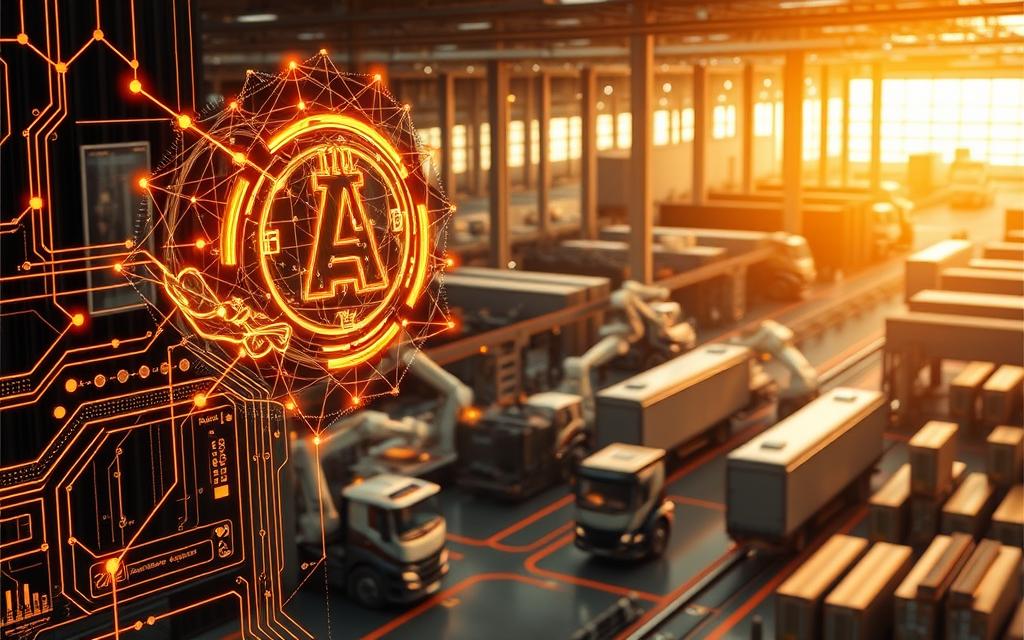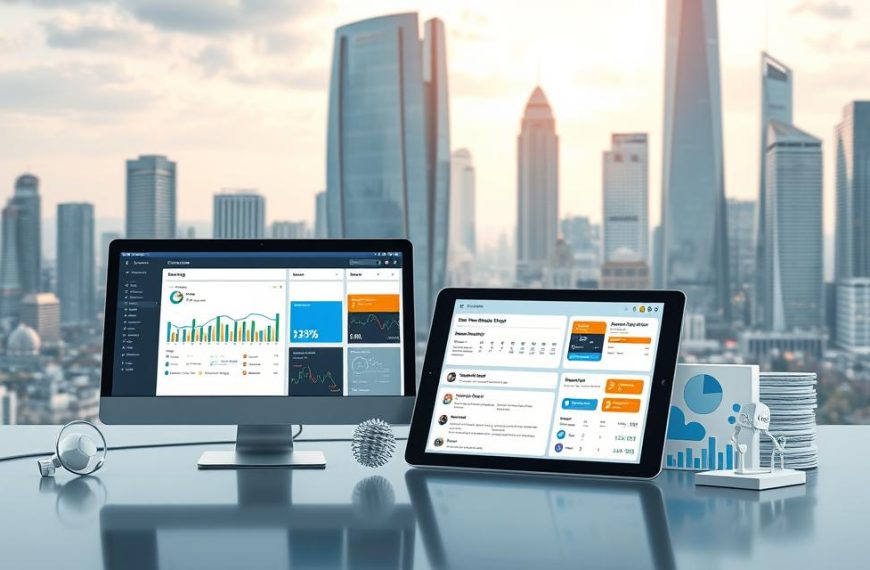Advanced technologies are redefining the way companies function. Among them, artificial intelligence stands out, driving unprecedented improvements in efficiency and decision-making.
Nearly all industry leaders agree—94% consider these innovations essential for future success. From inventory tracking to predictive maintenance, AI-powered solutions optimize workflows with remarkable precision.
Real-world results speak volumes. Organizations report 50% fewer forecasting errors and 30% less equipment downtime. IBM’s Maximo Suite exemplifies this shift, delivering $160 million in supply chain savings.
By merging human expertise with machine intelligence, enterprises unlock new potential. The impact spans every sector, proving that smart management of tasks leads to measurable growth.
Introduction: The AI Revolution in Business
Forward-thinking enterprises now rely on data-driven tools to maintain a competitive edge. Across industries, 73% of leaders credit intelligent systems with improving decision-making accuracy. Yet, only 29% effectively harness data to explore new market opportunities.
Traditional methods are fading. Retail giants like Walmart use predictive analytics to optimize inventory, while manufacturers deploy AI-powered sensors for real-time equipment monitoring. The result? A 40% drop in unplanned downtime.
Consider Electrolux’s breakthrough. By integrating AIOps, the company slashed IT resolution time from three weeks to one hour. Such gains highlight the untapped potential of machine-assisted workflows.
Key Industry Adoption Rates
| Industry | Adoption Rate | Primary Use Case |
|---|---|---|
| Healthcare | 68% | Diagnostic imaging analysis |
| Finance | 72% | Fraud detection algorithms |
| Retail | 61% | Personalized customer recommendations |
Beyond efficiency, sustainability gains emerge. Google’s DeepMind reduced data center cooling costs by 40% using energy optimization algorithms. Meanwhile, NLP advancements unlock insights from unstructured data—like customer reviews or legal documents.
The future workforce adapts too. Companies like Boeing employ VR simulations for technician training, cutting onboarding time by half. As technology evolves, its role becomes inseparable from long-term success.
How AI Is Revolutionizing Business Operations
Companies worldwide are adopting cutting-edge tools to streamline workflows and boost productivity. Two powerful approaches—robotic process automation and predictive analytics—deliver measurable results across industries.

Streamlining Workflows Through Automation
Repetitive tasks consume valuable time and resources. Robotic process automation (RPA) transforms these processes by handling rule-based activities with perfect accuracy.
- Deloitte reduced financial report preparation from days to hours using RPA
- Expense reporting now takes 10 minutes instead of 3 hours
- Data entry errors dropped by 72% after implementation
Manufacturers benefit too. Automated quality checks detect defects 40% faster than manual inspections. This prevents costly recalls and maintains brand reputation.
Data-Driven Strategies for Better Outcomes
Predictive analytics turns historical data into actionable insights. By identifying patterns, organizations make smarter decisions about future needs.
Retailers using these tools see dramatic improvements:
- 65% reduction in lost sales through optimized inventory
- Demand forecasts analyze 15+ variables for accuracy
- Social media sentiment helps predict buying trends
Equipment maintenance also evolves. Sensors detect potential failures before they occur, saving 30% on downtime costs. This proactive approach extends asset lifespan while reducing unexpected repairs.
Natural language processing adds another layer of value. It extracts key information from customer interactions, helping teams address concerns faster and improve service quality.
AI-Powered Data Analysis and Insights
Modern enterprises leverage intelligent tools to decode complex market signals. By merging data from IoT, CRM, and ERP systems, teams uncover actionable insights with 97% accuracy. Bouygues Telecom, for instance, saved $5 million by predicting network issues before outages occurred.
Real-Time Market Trend Predictions
Forecasting errors drop by 50% when algorithms analyze historical data and social media sentiment. Retailers like Target adjust pricing dynamically by tracking competitor trends and inventory levels.
“Patterns in purchasing behavior reveal opportunities invisible to traditional methods,”
notes a McKinsey report.
- Multi-source integration reduces blind spots in market analysis
- Foot traffic analytics optimize store layouts in real time
- Automotive manufacturers detect defects early, cutting recalls by 30%
Personalizing Customer Experiences
Recommendation engines boost conversions by 35% by tailoring suggestions to individual preferences. Machine learning maps cross-channel journeys, while churn models predict attrition with 89% accuracy. Starbucks’ rewards program, fueled by customer data, increased repeat visits by 25%.
Predictive service tools also preempt issues. For example, Zappos resolves 60% of complaints before customers contact support. This proactive approach elevates brand loyalty and lifetime value.
Transforming Customer Service with AI
Smart solutions are reshaping customer interactions, delivering faster responses and personalized support. Companies now deploy technologies like NLP-powered chatbots to handle 82% of routine inquiries, slashing wait times by 75%. These tools learn from every interaction, refining responses to match individual needs.

24/7 Chatbots and Virtual Assistants
Modern customer service thrives on immediacy. Virtual assistants detect emotions in voice or text, escalating complex issues seamlessly. Key features include:
- Real-time agent suggestions from knowledge bases
- Multilingual support across 15+ languages
- Automated post-call summaries, cutting admin time by 40%
“Businesses using AI-infused agents reduce costs by 30% while boosting satisfaction,”
Case Study: Bouygues Telecom’s Success
This telecom giant achieved a 400% ROI within a year by integrating AI. Results speak volumes:
| Metric | Before AI | After AI |
|---|---|---|
| Defect Detection | 70% | 97% |
| Call Volume | 100% | 30% |
| Annual Savings | – | $5M |
Sentiment analysis triggered proactive resolutions, improving self-service rates from 45% to 68%. For deeper insights, explore how AI transforms interactions in Forbes’ latest report.
Optimizing Supply Chains with AI
Leading corporations achieve 100% fulfillment rates through data-driven logistics. Predictive analytics transform traditional methods, reducing shortages by 65% while adapting to market trends in real time. These systems analyze everything from weather patterns to social media sentiment.

Demand Forecasting and Inventory Management
Dynamic routing slashes fuel costs by 18% through optimized delivery paths. Perishable goods benefit from shelf-life prediction models that reduce waste by 40%.
Key advancements include:
- Blockchain integration for end-to-end shipment visibility
- Automated customs forms processing 300% faster than manual entry
- Warehouse robots coordinating pick routes with 99.9% accuracy
IBM’s AI-Driven Supply Chain Savings
The tech giant’s cognitive management platform delivered remarkable results:
| Metric | Improvement |
|---|---|
| Crisis response | 34% faster |
| Inventory costs | $160M saved |
| Carbon footprint | 12% reduction |
“Geopolitical risk assessments prevent 80% of potential supplier disruptions,”
Multi-echelon optimization balances stock levels across global networks. Raw material price algorithms adjust procurement strategies weekly, maintaining cost efficiency even during market volatility.
Overcoming Challenges in AI Implementation
While AI delivers transformative benefits, deployment isn’t without obstacles. Only 33% of leaders leverage data for pricing strategies, highlighting gaps in adoption. Successful integration demands addressing privacy concerns and workforce readiness.

Data Privacy and Regulatory Hurdles
Compliance tools automate GDPR and CCPA requirements, reducing legal risks. Synthetic data generation preserves privacy while training models effectively. IBM’s governance framework reduces bias incidents by 45%.
Key solutions include:
- Hybrid cloud deployments for sensitive data isolation
- Ethical AI certifications to build consumer trust
- Automated audit trails for transparency
“Vendor lock-in raises costs by 22% compared to open-source alternatives.”
Bridging the AI Skills Gap
Upskilling programs cut implementation time by 40%, as seen at JPMorgan Chase. Structured learning paths help teams master predictive tools faster. Change management metrics show 58% higher adoption with hands-on training.
Effective approaches:
- Partnering with Coursera for specialized certifications
- Internal mentorship programs
- ROI dashboards to track progress
Companies like Pfizer reduced resistance by demonstrating 1000+ annual hours saved through AIOps. Measurable outcomes accelerate cultural acceptance of new technologies.
The Future of AI in Business Operations
Next-generation enterprises are shaping a smarter operational landscape with intelligent automation. By 2025, 80% of organizations will integrate self-healing technologies to minimize downtime. These advancements merge sustainability with efficiency, creating a blueprint for the future.
Emerging Trends: AIOps and Sustainability
AIOps platforms now predict IT failures 48 hours in advance, reducing resolution time by 60%. Circular economy algorithms optimize resource use, cutting waste by 40% in manufacturing. Key breakthroughs include:
- Augmented reality overlays guide technicians, improving repair accuracy by 55%.
- Smart buildings adjust energy use in real time, lowering carbon footprints by 15% annually.
- Automated ESG reporting tracks progress against sustainability goals with 90% fewer errors.
“Companies leveraging AIOps achieve 30% faster incident response and 25% lower infrastructure costs.”
Preparing for an AI-Driven Workforce
VR simulations now train employees 3x faster, with 55% higher skill retention. Predictive models identify skill gaps, enabling targeted learning programs. Workforce analytics reveal actionable insights:
| Metric | Impact |
|---|---|
| Upskilling Speed | 40% faster |
| Employee Satisfaction | +22 points |
| Leadership Readiness | 68% improvement |
Continuous learning platforms adapt to individual progress, closing competency gaps. Human-AI collaboration tools track performance, ensuring seamless integration of technologies into daily workflows.
Conclusion
The shift toward intelligent automation marks a turning point for modern enterprises. Organizations report 45-60% efficiency gains in supply chains, customer service, and data analysis. A phased adoption roadmap ensures seamless integration of these technologies.
Ethical governance frameworks are critical. IBM’s Maximo Suite demonstrates ROI, with $160M saved in inventory costs. By 2026, 83% of firms will use AIOps to streamline processes.
Workforces adapt through upskilling, with VR training cutting onboarding time by half. The future belongs to businesses leveraging intelligence for sustainable growth. Start assessing readiness today to unlock these opportunities.









